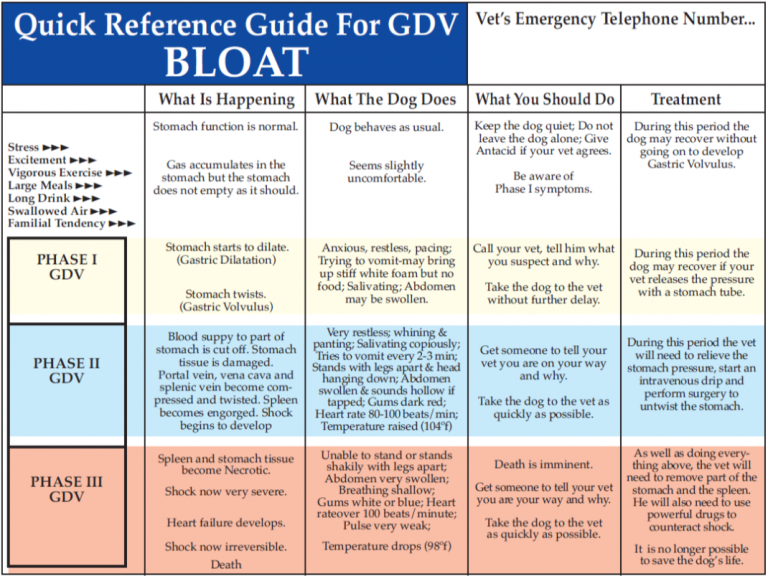GDV (better known as Stomach Torsion or Bloat)
GDV actually stand for ”Gastric Dilatation and Volvulus” and in essence it only means a stomach that twisted or turned on its own axis and if going through 180 degrees it obstructs the inlet and outlet and thus cause the stomach to Bloat. This is always a medical emergency!!
Sadly, even with emergency treatment, up to 50% of dogs will die if their stomach has twisted.
Though this can theoretically happen in any dog, there are definitely certain breeds that are more prone to GDV. These breeds include English bulldogs, Weimaraners, Rottweilers, German shepherds, Great Danes, and any other large, deep-chested breed. Though it seems like it’s a genetic breed tendency, it’s really more a factor of the anatomy of these breeds based on their size and shape. Studies have looked at how to prevent it, and there is really only one thing that has been shown to significantly increase the risk–exercise after filling the stomach with food or water. So take a dog of the right size and breed, fill their stomach with food or water, then let them run around a lot. That’s a formula for bloat.
Dogs that bloat most commonly act and look like they swallowed a large beach ball. Their abdomen becomes large and
tense, their gums can become pale, they will become suddenly lethargic, and will usually act like they are gagging or retching and salivating excessively. If you see your dog act like this with a bloated belly, consider this a life-or-death emergency and see a vet immediately.
Symptoms of bloat in dogs
Bloat develops very suddenly, and occurs more in middle aged or older dogs. Often the dog may have just eaten a large meal, drank a large amount of water or been exercising vigorously before or after eating when the first symptoms of bloat appear.
Five early warning signs of bloat in dogs may include:
- Your dog is drooling more than usual
- Your dog is trying to be sick, but not able to vomit
- Your dog has a tight or swollen stomach
- Your dog is tired but restless
- Your dog appears to be uncomfortable or in pain and may groan, whine or grunt – particularly if the stomach is touched or pressed
As the problem progresses, your dog may go into shock, with pale gums and tongue, rapid heart rate, weak pulse, problems breathing and collapse.
If there is any suspicion of bloat, take your pet to the nearest vet hospital. If the stomach has twisted, then emergency surgery is the only option
Here are some precautions to take to help prevent this deadly condition:
- Wait at least one hour after eating or drinking before allowing exercise. This is the main factor shown to prevent bloat.
- Don’t encourage your dog to roll over. Though a low risk, the twisting action has been shown to lead to bloat. In fact, some veterinarians do not rotate a dog over their back while anesthetized due to this risk.
- Feed 2-3 meals during the day rather than one large meal. However, be sure that you’re taking the measured amount of daily food and dividing it into the meals rather than giving the once daily amount two or three times.
- Don’t allow excessive water drinking immediately before or after a meal. Abnormal amounts of water have the potential to delay breakdown of food and lead to gas production.
Dogs who have had episodes of GDV are at risk for further occurrences. A surgery can be performed to attach the outside lining of the stomach to the body wall (gastropexy). While this doesn’t completely prevent the stomach from rotating, it does lower the risk. Some advocate having this surgery performed routinely on high-risk breeds, but personally I disagree. Even in breeds that are prone to bloat most will never have this happen in their life span, and I don’t think the benefits of the procedure (since it’s not a guarantee that it will never happen) outweigh the risks. Remember, this is only in cases of preventative surgery. I certainly do think that it should be done in a dog who has bloated once since they show a personal tendency and it will very likely happen again.
A Gastropexy simply stops the stomach from twisting, which is the cause of the life endangering symptoms. However, your dog can still get bloat after the surgery, although they will be able to burp and pass excess gas which means you have more time to get to your vet for treatment. It turns a life-threatening emergency into something with significantly less risk.
See the attached quick reference bloat-chart drawn up by Great Dane Rescue North Texas to help you recognise the signs and determine severity of bloat in your Dane and what stand you to do.
Dr. Carel Breytenbach (BVSc)
Muldersdrif Dierekliniek

